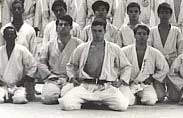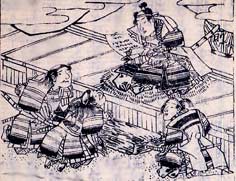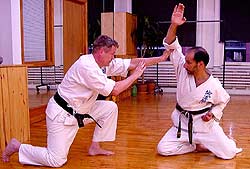Seiza: The Kneeling Posture
By Christopher Caile
Seiza. It is the basic kneeling position used at
the beginning and the end of martial arts classes
and is associated with bowing in respect for teachers
and other students.  In
this posture the knees are bent 180 degrees with the
calves tucked under the thighs so you sit on your
heels, toes pointed. In
this posture the knees are bent 180 degrees with the
calves tucked under the thighs so you sit on your
heels, toes pointed.
Few today, however, give it more than a momentary
thought, other than the pain so often felt in the
ankles and legs, or the growing discomfort felt when
sitting this way for long. And when westerners sit
this way for very long often their legs go to sleep.
So why do we sit this way and what is its value?
After all, in the west most people sit in chairs or
lounge across their sofas. There is no history or
lifelong adherence to a method of kneeling on the
floor. Is seiza anything more than a quaint Asian
cultural artifact?
In Japan this method of sitting has always been associated
with proper etiquette. In modern karate-do, aikido,
kung fu and in many other arts, the role of proper
etiquette is a vehicle to show respect, develop discipline
and train the mind and body. By being respectful you
show appreciation for your art, your study, the teacher
and other students. It becomes a triumph of spirit
over ego, an acknowledgment of the importance of others
and the group over the self. In this form etiquette
represents willful discipline of the mind and development
of spirit.
Seiza and proper etiquette, however, did not always
serve this same purpose. Many elements of etiquette
that developed during feudal periods of armed warfare
(roughly the 12th through the 17th centuries) -- such
as where to hold your hands, how to bow, walk, move,
or sit, where to sit and the distance expected from
others -- all at their core were intimately linked
to the practice of sword and other weapon arts, as
well as to strategies of self-defense and the ability
to react instantaneously.
 Warriors
were almost always armed and even when they slept
a weapon was always close by. At any time warriors
had to be ready for immediate reaction and mobility
-- when outside, in town, when visiting others, in
the presence of their superiors or lord, when eating
and drinking with friends, when escorting others or
on campaign or in battle. Necessity dictated constant
awareness of everything around them, the position
of others, their environment and always their ability
to react or defend themselves. Warriors
were almost always armed and even when they slept
a weapon was always close by. At any time warriors
had to be ready for immediate reaction and mobility
-- when outside, in town, when visiting others, in
the presence of their superiors or lord, when eating
and drinking with friends, when escorting others or
on campaign or in battle. Necessity dictated constant
awareness of everything around them, the position
of others, their environment and always their ability
to react or defend themselves.
Some samurai took this to the extreme. One story
says that legendary Miyamoto Musashi (1600 era), the
Japanese masterless samurai famed for his many successful
challenges of others, was so fearful of being exposed
(without his sword) that he refused to ever take a
traditional bath.
In this warrior context, if seiza was incorrectly
executed, or the kneeling person was lax in his positioning,
it could have fateful consequences. Inside a dwelling
a razor sharp short sword (often a short knife was
also present) was often positioned at their left side
just inches from their hand. When outdoors, a longer
sword was added, also positioned at their left side
(through a sash) or slung across their back.
 Warriors
were taught how to draw a weapon instantly, from seiza
and other positions, to strike or parry an attack.
Today, this art of sword drawing is most often practiced
as a specialty known as iaido (the art of drawing
the sword). When formally sitting in seiza, the ability
to rise up from a kneeling position instantaneously
with the right leg forward simplified the sword drawing,
positioned the practitioner for further movement and
closed the distance to his antagonist. This was all
done with such speed that the rise from seiza, cut
and sword's re-sheathing could be done by the most
accomplished in a blink of an eye. What made all this
possible was proper seiza technique. Warriors
were taught how to draw a weapon instantly, from seiza
and other positions, to strike or parry an attack.
Today, this art of sword drawing is most often practiced
as a specialty known as iaido (the art of drawing
the sword). When formally sitting in seiza, the ability
to rise up from a kneeling position instantaneously
with the right leg forward simplified the sword drawing,
positioned the practitioner for further movement and
closed the distance to his antagonist. This was all
done with such speed that the rise from seiza, cut
and sword's re-sheathing could be done by the most
accomplished in a blink of an eye. What made all this
possible was proper seiza technique.
 Likewise,
from sieza position many warriors learned empty hand
defenses against a sword strike or other attack. A
defender could pivot to the side instantaneously to
avoid and control a weapon thrust (careful that the
knees were not too widely spaced to maintain balance
while pivoting) or move forward into a downward weapons
strike in order to intercept the striking arm before
the attack was fully generated or control a weapon
strike coming downward at an angle from the side.
Today many empty hand self-defenses are still practiced
in diato ryu, aikido, many forms of jujutsu as well
in some other arts. Likewise,
from sieza position many warriors learned empty hand
defenses against a sword strike or other attack. A
defender could pivot to the side instantaneously to
avoid and control a weapon thrust (careful that the
knees were not too widely spaced to maintain balance
while pivoting) or move forward into a downward weapons
strike in order to intercept the striking arm before
the attack was fully generated or control a weapon
strike coming downward at an angle from the side.
Today many empty hand self-defenses are still practiced
in diato ryu, aikido, many forms of jujutsu as well
in some other arts.
But these skills no longer receive the same emphasis
in many modern "do" arts, such as karate-do,
judo and others. As a result some of the subtleties
of proper kneeling and moving have been lost. In other
cases just the outer form of etiquette has been maintained,
while the original intent, rationale and meaning have
been lost to the new ends of "do" oriented
arts.
This evolution in itself should not necessarily be
considered unfortunate, or those who practice the
new seiza etiquette should not be considered as "doing
it wrong." Westerners aren't used to sitting
in seiza, and the art there practice has a different
emphasis.
The principles of traditional seiza are simple. Upon
sitting, the left leg is bent and moved behind, the
toes of the left foot maintaining contact with the
floor as the shin in lowered, the right leg being
forward and bent. As your buttocks sink the right
leg is likewise pulled back -- both feet now being
supported by the toes. Only then are the toes allowed
to move backward so the instep lies flat, the feet
pointed in an a angle (they can be kept apart or the
big toe of each foot can touch). The hands are then
positioned across the thighs.
The toe position is critical. If the leg and instep
are placed flat with the toes pointed, mobility and
balance are lost if you try to move forward to one
leg, or otherwise move. For a warrior, such a technique
would be dangerous since stability would be sacrificed,
and a foe observing such behavior would be alerted
to an interval of advantage.
To stand from seiza the right leg moves first. But
first as the buttocks begin to rise the toes of both
feet pull back with the tips of the toes on the ground,
Thus as the right leg moves forward, the toes of the
opposite foot support a quick, balanced, powerful
forward motion -- the movement of the body forward,
supported with the right leg providing momentum and
mobility behind any sword cut, parry, empty hand defense
or transition to standing (in empty hand self-defense
situations, however, sometimes the left leg comes
up first).
Try this experiment. Sit in seiza with your toes
pointed. Try to move quickly and powerfully forward
or quickly rise. Now try the same with the toes turned
to the floor. You should feel a dramatic difference.
An alternative exercise is to start to sit, just
by collapsing your legs, or by moving one leg back
but with the toes pointed. See how you can react to
an attack from the front, or a push backwards. Check
the stability in this position against that evidenced
during traditional kneeling.
It is true that in judo, karate-do, taekwondo and
many other arts there is no longer an active link
to the sword arts or necessity to practice self-defense
from seiza. But the practice of traditional seiza
does force a heightened state of mental readiness,
and awareness, and attention to position and balance.
It also maintains a combative link to self-defense
scenarios of our warrior heritage and by doing so
creates an atmosphere of seriousness around practice
that can be easily forgotten -- an integration of
attitude with technique.
Acknowledgement: FightingArts.com
would like to thank Sensei Robin Brown of New York
City's Hakuho Kai Daito Ryu Aikijujtsu for demonstrating
the proper fundamentals of sitting in Seiza.
About The Author:
Christopher Caile has been a student of the martial
arts for over 40 years, and a teacher for more than
35 years. He has an MA in International Relations
with a specialty in southeast Asia, and has lived
and traveled in Japan, Okinawa and south and southeast
Asia. He is 6th degree black belt in Seido karate
under Kaicho Tadashi Nakamura, a long time student
of aikido under Roy Suenaka (Wado-kai aikido), as
well as a student of other martial arts (including
daito ryu aikijujutsu, judo, boxing and several
Chinese arts) and Zen. He is also a teacher of qi
gong (Chinese energy medicine), in which he trained
under Master Zaiwen Shen and is Vice-President of
the DS International Qi Medicine Association.
In his business career he has been a newspaper
journalist and entrepreneur of several business
ventures, and he designed innovative telecommunication
and marine products which were developed in companies
he founded. In 1999 he founded FightingArts.com
(which went live in August 2000) and its parant
company eCommunities LLC.

back
to top
home
| about
us | magazine
| learning
| connections
| estore
|